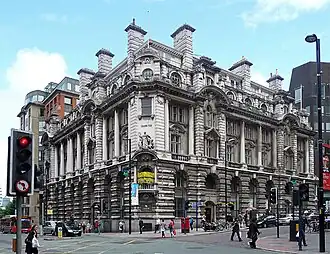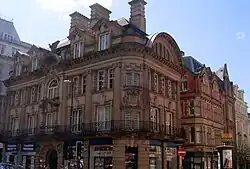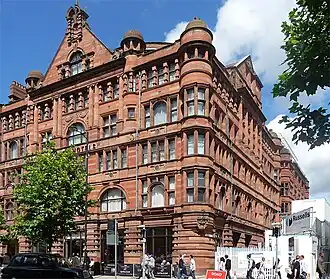Charles Henry Heathcote
Charles Heathcote | |
|---|---|
 | |
| Born | Charles Henry Heathcote 2 April 1850 Manchester, England |
| Died | 16 January 1938 (aged 87) Bournemouth, England |
| Nationality | English |
| Occupation | Architect |
| Buildings | 107 Piccadilly (1899), Piccadilly Parr's Bank (1902), York Street Eagle Star Building (1911), Cross Street Lloyds Bank (1915), King Street |
| Projects | Trafford Park, Trafford |
Charles Henry Heathcote (2 April 1850–16 January 1938)[1] was a British architect who practised in Manchester. He was articled to the church architects Charles Hansom, of Clifton, Bristol. He was awarded the RI Medal of Merit in 1868, and started his own practice in 1872.
Heathcote built city centre buildings such as Parr's Bank (1902) on York Street, the Eagle Star Building (1911) on Cross Street, Lloyds Bank (1915) on King Street, and the earlier 107 Piccadilly textile warehouse (1899).[2] He helped plan the Trafford Park industrial estate, working for British Westinghouse and the Ford Motor Company. He designed 15 warehouses for the Manchester Ship Canal Company. He also worked on the buildings for Richard Lane's Cheadle Royal Lunatic Asylum.[1]


Buildings
Listed buildings at Grade II* and Grade II:
- 53 King Street, Lloyds Bank, 1915 (later Lloyds TSB, now a restaurant)[3]
- Northern Rock Insurance, corner of Cross Street and King Street, 1895[4]
- Eagle Insurance Building, 68 Cross Street, 1911[5]
- Anglia House, 86 Cross Street, 1904[6]
- Royal London House, 188–202 Deansgate, 1904[7]
- Onward Buildings, 205–209 Deansgate, 1903–05[8][9]
- 107 Piccadilly for Sparrow Hardwick & Company, 1898 (now an Abode Hotel)[10]
- Commercial Union Buildings, 47 Spring Gardens, 1881–82[11]
- 1–3 York Street, corner of Spring Gardens, 1902 (formerly Parr's Bank, Grade II*)[12][13]
- Joshua Hoyle Building, 50 Piccadilly, 1904[14][15]
Other
- Dental Hospital, Oxford Road, University of Manchester, 1908[16]
- 7–9 Piccadilly, with W. A. Thomas, 1910 (demolished)[17]
Heathcote & Rawle Grade II listed
- Alliance House, 28–34 Cross Street, 1901[18]
- Lancashire & Yorkshire Bank, 43–45 Spring Gardens, 1890[19][20]
See also
References
- ^ a b Cocks, Harry; Wyke, Terry (2004), Public sculpture of Greater Manchester, Liverpool: Liverpool University Press, p. 448, ISBN 0-85323-567-8
- ^ [1] Archived 26 August 2010 at the Wayback Machine
- ^ Historic England. "Former Lloyds Bank (1291610)". National Heritage List for England. Retrieved 16 July 2025.
- ^ Historic England. "No. 74, King Street (1197939)". National Heritage List for England. Retrieved 16 July 2025.
- ^ Historic England. "Eagle House (1209494)". National Heritage List for England. Retrieved 16 July 2025.
- ^ Historic England. "Anglia House (1197768)". National Heritage List for England. Retrieved 16 July 2025.
- ^ Historic England. "Royal London House (1200852)". National Heritage List for England. Retrieved 16 July 2025.
- ^ "The Onward Building". Manchesterhistory.net. Archived from the original on 15 February 2012. Retrieved 14 October 2013.
- ^ Historic England. "Onward Buildings (1210092)". National Heritage List for England. Retrieved 16 July 2025.
- ^ Historic England. "107, Piccadilly (1246944)". National Heritage List for England. Retrieved 16 July 2025.
- ^ Historic England. "47, Spring Gardens (1254676)". National Heritage List for England. Retrieved 16 July 2025.
- ^ Later National Westminster Bank and now converted to other uses
- ^ Historic England. "Former National Westminster Bank on corner at junction with Spring Gardens (1255042)". National Heritage List for England. Retrieved 16 July 2025.
- ^ "Joshua Hoyle Building, Including Roby House – Manchester – Manchester – England". British Listed Buildings. Retrieved 14 October 2013.
- ^ Historic England. "Joshua Hoyle Building, including Roby House (1271127)". National Heritage List for England. Retrieved 16 July 2025.
- ^ Historic England. "Former Department of Metallurgy, University of Manchester, and attached railings (1254639)". National Heritage List for England. Retrieved 16 July 2025.
- ^ "Ceylon Tea House 7 & 9 Piccadilly". Manchester Victorian Architects. Architects of Greater Manchester 1800–1940. Retrieved 16 July 2025.
- ^ Historic England. "Alliance House (1209486)". National Heritage List for England. Retrieved 16 July 2025.
- ^ "Manchester Buildings and the Architects who built Manchester?". Manchester2002-uk.com. Archived from the original on 18 October 2002. Retrieved 14 October 2013.
- ^ Historic England. "43 and 45, Spring Gardens (1254639)". National Heritage List for England. Retrieved 16 July 2025.
Further reading
- Hartwell, Clare (2001). Manchester. Pevsner Architectural Guides. Yale University Press. ISBN 0-300-09666-6.
- Parkinson-Bailey, John J. (2000). Manchester: An Architectural History. Manchester University Press. ISBN 978-0-71905-606-2.